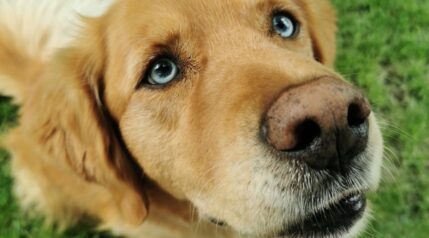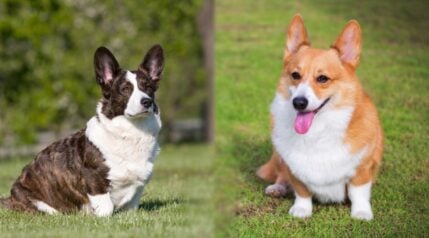If you’ve ever seen a Corgi Golden Retriever mix, we can bet that your heart melted in a second. These adorable dogs often look like Golden Retrievers with small legs. Their cuteness has made them increasingly popular in the last decade or so.
Golden Retrievers are some of the most sought-after dogs in the United States. Corgis are also quickly climbing the list, making this mixed breed an awesome option for families or older people who want a dog with the friendliness of a Golden Retriever but a pup that’s smaller in size like the Corgi. Meet the Corgi Retriever, an irresistibly cute designer breed.
These dogs are known for their friendly temperament and adorable appearance. However, there are a few things you should know about the Corgi Golden Retriever mix before you rush out to buy one.
History
To understand this mix, it helps to learn a little about each parent breed. These pups are part of the designer dog breed trend, the mixing of two desirable parents to create a pup with the best qualities of both.
Golden Retriever

Golden Retrievers are beloved for their sweet nature and beautiful appearance. They are consistently one of the most popular breeds in the country and world. Goldens hail from Scotland and were developed as hunting companions in the nineteenth century. They were started as a cross between a Tweed Water Spaniel and a Retriever, mixed with other breeds like Bloodhounds and Irish Setters.
They are also a perfect pick to crossbreed with due to their amicable personality and gorgeous appearance. The Goldendoodle, a mix between the Golden Retriever and Poodle, is one of the most sought-after mixed breeds of all time
Corgi

Both varieties, the Cardigan and Pembroke Welsh, come from Wales, but they are not the same breed. Cardigans can be traced to the Celts and were brought to Wales around 1200 BC. They were working dogs, herding the livestock, and helping on the hunt.
Pembrokes hail from Belgium and were companions to weavers as they immigrated to Wales. Pembrokes also worked as herding dogs. Today, both varieties are wildly popular pets around the world.
For this guide, we will be referring specifically to the Pembroke Corgi, as this is the most common variety in America.
Appearance

They do not have set traits and appearances like purebred dogs do. Getting a mixed breed is a lot like flipping a coin.
The Corgi Golden Retriever mix can look like either parent or be a strange mix between the two. To figure out how a Corgi Retriever might look, let’s take a look at each parent breed.
Corgi Appearance

Corgis are best known for their short legs, large, pointed ears, and delightfully cute butts. Their head has been described as “foxy” in appearance.
The Corgi’s short legs are the result of a genetic mutation. While their legs are their defining feature, they are also the cause of a variety of health problems, which we will discuss later.
These dogs are pretty uniform in appearance, but there are a couple of “flaws” that are known to exist. Some Corgis are born with very long coats. They are usually called “fluffies.” Others are born with diluted coat colors and are called “bluies.” These dogs are usually sold as companion animals because they cannot be shown in most dog shows.
Some Corgis are born with their tails short or missing completely. Others have their tails docked, especially if they are working dogs. Many dogs who are companions, however, do not have their tails docked.
Golden Retriever Appearance

Golden Retrievers are medium-large dogs with weather-repellent coats. They were bred to retrieve game after it had been shot, so their coats are designed to protect them from the elements. The top coat is wiry, while the lower coat is softer.
These dogs come in a few different variants, depending on where you live. There is a distinct “American” version and then a separate “British” version. The British type is more muscular, while the American type tends to be quite lanky. The American type also has darker-colored coats, though they come in the same general colors.
No matter the type, Goldens have the same general features. The coat is usually medium-length. Care is taken to ensure that it doesn’t get too long, as this can be a problem in the field.
Puppies are typically lighter colored than adults, so you don’t really know what color you’re getting when you choose a puppy. The dog’s coat can change shades at various points in its lifetime.
Corgi Golden Retriever Mix Appearance

Corgis reach between 20 and 30 pounds, while Goldens reach between 55 and 75 pounds. A mix of these two can weigh anywhere from 25 to 70 pounds. They stand between 9 and 18 inches tall.
Their legs can be short. However, they will never be as short as an actual Corgi’s. Depending on the Corgi parent, however, this mixed breed may not have short legs at all.
Typically, a good breeder will be able to give you some idea as to the size of the puppy’s legs. You can also tell leg length after a puppy is born, though you will not be able to see exactly how tall they are until they are grown.
Their coats will typically be some sort of golden color. The exact color depends a lot on the Golden Retriever parent. The best way to get an idea of what a puppy will look like when grown up is to look at its parents.
Temperament
While most purebreds have common personality traits, this is not necessarily true for mixed breeds. Genetics plays a pretty big part in how a dog acts. However, the environment they grow up in also plays a role.
Socialization at an early age is vital. Puppies should be introduced to a variety of different sights and sounds at an early age. The more they interact with the world when they’re growing, the lower the chance for aggression when they get old.
With that said, genetics can still predispose a dog to act in a particular way. Let’s take a look at the personality of each parent breed to see how this mixed breed might act.
Corgi Temperament
Corgis love their people. They are affectionate and bond readily to their family. Your Corgi will likely follow you around the house.
They have a strong desire to please their people, which makes training decently easy. It is not difficult to get them to do what you want them to. Corgis are also fairly intelligent, though not as much as some other breeds.
These dogs were originally used as herding dogs. However, they have been utilized for a number of other jobs as well. They are occasionally used as watchdogs due to their high level of alertness and usually quiet nature. They only bark when necessary, which makes them highly suitable for apartments.
Because of this dog’s herding instinct, they are not the best choice for homes with children. They might instinctively bite at a child’s heels in an attempt to “herd” them. This can be quite frightening for the child and can progress into aggression if the situation is not handled correctly.
They might also try to herd other animals. They don’t really chase cats as much as they try to herd them. Socialization can curb some of these instincts. However, they will never completely go away.
Golden Retriever Temperament
The Golden Retriever’s gentle temperament is one of the big reasons they’re so popular. Like the Lab, they are often described as friendly, outgoing, and affectionate. They make good family pets, even if you have children or other animals.
Goldens are agreeable with everyone. They are not particularly protective or territorial. In most cases, they don’t mind people coming over to their homes or interacting with their owners.
Their trusting nature makes Goldens poor guard dogs. However, this also means that they are very unlikely to be aggressive, though they still require socialization to avoid fear-driven aggression.
Golden Retrievers are also very intelligent. They perform well in obedience training and pick up on commands easily. Furthermore, they like to appease their owners, so it is not difficult to get them to perform their commands.
These are active dogs, but they can sit still when required. They are not typically hyperactive as long as they get the appropriate amount of exercise. They are quick to learn, and Goldens crate train very easily as long as they have a crate with an appropriate amount of space.
Corgi Golden Retriever Mix Temperament
You can expect this mixed breed to be friendly and people-pleasing. Both the Corgi and the Golden Retriever are laid-back, friendly dogs, so it is likely that their puppies will be too.
Training should be moderately easy for the Corgi Retriever. They are quite intelligent and enjoy training. We recommend about 15 minutes of obedience training a day to keep them stimulated while also curbing any negative behaviors they might have.
While these dogs are not prone to aggression, socialization is still important. Dogs who are socialized properly have a much lower chance of becoming aggressive.
This breed will not have guarding instincts, but fear-driven aggression is still possible. The best way to avoid any possible fear problems is to introduce them to a variety of different situations, people, and animals.
Health

For the most part, mixed breeds are healthier than their purebred counterparts. This is because mixed breeds come from a larger gene pool. The bigger the gene pool, the less likely they are to inherit genetic defects.
Most purebred dogs come from a very small gene pool. In fact, most purebred dogs were likely the result of inbreeding. Dogs from smaller gene pools are more likely to inherit traits that are much rarer in the general population- like the Corgi’s small legs, for instance.
While these traits often set purebred dogs apart, they often result in negative health effects.
This is true for the Corgi. Their short legs are what defines them as a breed, yet they also cause a variety of health problems.
Still, there are a couple of diseases the Corgi Golden Retriever mix is prone to, and it is important for you to be aware of them before deciding whether or not to adopt them.
Intervertebral Disk Disease
Intervertebral disk disease, often shortened to IVD, is a back problem that is common in specific dog breeds. This disease occurs almost exclusively in breeds with short legs and long backs, such as the Corgi or Corgi mixes.
In these breeds, the long back is not supported properly by the legs, which can cause excess spinal pressure. The dog’s back almost begins to resemble a rope bridge – drooping in the middle.
This causes inflammation in the spinal column and can lead to degeneration of the vertebrae in the spine. This inflammation can press on the nerves, which results in IVD.
When IVD occurs, the dog usually experiences pain, paralysis in its lower body, weakness, loss of bladder control, and eventually, the inability to feel pain in the limbs at all.
Usually, the dog will suddenly have weakness in their back legs and lose mobility. They might express that they are in pain. As the disease progresses, the paralysis will become worse. They will slowly lose the use of their legs until they eventually cannot feel them at all.
The prognosis for this disease is mixed. It can sometimes be treated in mild cases with oral anti-inflammatories. Crating a dog and preventing movement has also been successful. The less a dog moves, the more likely it is that the inflammation in their spinal cord will go down. Surgery is also a common treatment, though it is normally only used as a last resort.
Early treatment is very important in all cases. Nerve damage will continue until the inflammation is under control. The faster the inflammation is reversed, the more likely the dog is to recover. If the dog does improve, they will likely go on to live a full life. It is not uncommon for them to develop this condition again.
Grooming
The amount of grooming this mixed breed requires depends on how much hair they have. Those with longer hair will need more regular brushing and will likely shed more, while those with shorter hair will require less brushing.
Overall, however, these are low-maintenance dogs. They do not require regular trips to the groomers and usually only need to be brushed a couple of times a week.
These dogs shed year-round. However, they will shed particularly badly at least twice a year during seasonal temperature changes. This is called “blowing” their coat. During these periods, they will shed nearly their whole lower layer of fur and often have visibly less hair when they’re done.
On top of the regular brushing, these dogs will need their nails clipped. Overgrown nails can be quite painful for a dog, so it is important to keep them cut to a proper length. You can do this at home or have it done professionally by a groomer.
They will also need their teeth brushed a few times a week. We know that brushing a dog’s teeth is hardly ever easy, but with enzymatic toothpaste designed for dogs, it can be done quickly and effectively.
If your dog has floppy ears, you will need to check them regularly to ensure they are not infected. Dogs with floppy ears are more prone to ear infections and ear mites, so it is important to keep an eye on them. Cleaning them regularly with a wet cotton ball is not a bad idea, especially if their ears have been previously infected.
Exercise

Despite their small size, these dogs have a lot of energy. Both their parent breeds were designed to work, so they have the endurance needed to get their jobs done.
A fenced-in backyard is useful but not absolutely necessary. On average, you can expect these dogs to need about thirty minutes of moderate to intense exercise a day. On top of this, they will also need to play off and on throughout the day, though not intensely.
These dogs also need regular mental stimulation. They are quite intelligent and, therefore, need to be kept entertained. Otherwise, they will try to make their own fun – which will often get them in trouble.
Regular obedience training is the easiest (and cheapest) way to accomplish this. Plus, while your dogs are enjoying the learning challenge, they’re also learning skills that can be helpful outside of training.
If regular obedience training isn’t possible or your canine needs more stimulation, puzzle toys are another way for them to stay busy. Simple games like hide-and-seek are also possible with these canines and are a fun way for younger children to get involved.
Breeders & Puppy Costs
These pups are both adorable to look at and have loving personalities, and they have a price tag that reflects that. Expect to pay between $1,000 and $2,000 for a high-quality puppy from a reputable breeder. Avoid pet store pups as they are often from puppy mills and are in poor health.
A quality breeder will allow you to meet the parents, show you health certificates, and answer any questions you have. You may find this mix in shelters or in breed rescues. A rescue pup can be a perfect option if you want an older dog, and is a wonderful way to save a life.
Have you ever met a Golden Retriever Corgi mix? Let us know all about it in the comments.
As Family Pets
The Corgi Golden mix makes a lovely, unforgettable family pet.
- They are a good size for small homes and apartments.
- This breed can be stubborn and a bit bossy, so you must have a commitment to setting boundaries and training.
- The Corgi parent has a risk of some serious health conditions, which is something to consider.
- Corgi Goldens are highly affectionate and love attention.
- This breed is good with crate training.
- They need plenty of daily interaction and exercise.
- Goldens have heavy coats and shed a lot, so your mixed-breed pup may need a good amount of grooming.
- These pups are friendly and enjoy the company of family and strangers alike.
Are You Ready For A Golden Retriever Corgi Mix?
If you are ready for a ton of cuteness, cuddles, and plenty of laughs, the Golden Corgi may be a perfect pick. If you have plenty of time and money and are ready for the responsibility of pet ownership, you will not regret bringing one of these pups home. However, they, like all dogs, require a considerable commitment. You must consider your living space, time, and ownership experience before bringing one of these fuzzy snuggle bugs home.






I have a question about this specific dog breed. Since it is not a purebreed dog will it cause this dog back conditions or harm, because i know sometimes, dogs with small legs can easily cause IVD. so just wondering if this dog breed is harmless for the dogs back.
Hi Andrine! Generally speaking, owning a mixed breed means you’ll have fewer health issues than owning a purebred. Every dog is different though, so we would just recommend you investigate the dog’s parents and prior litters prior to adopting. Thanks for stopping in!